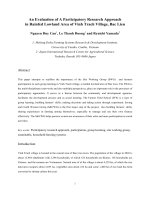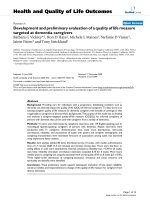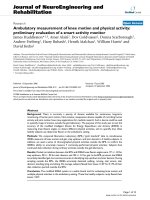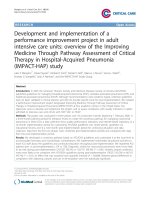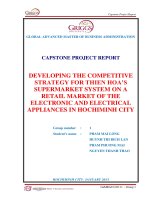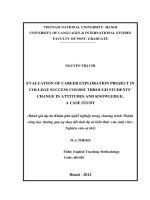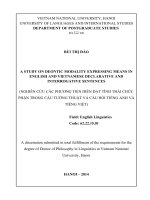Preliminary evaluation on a petroleum exploration project in Uzbekistan
Bạn đang xem bản rút gọn của tài liệu. Xem và tải ngay bản đầy đủ của tài liệu tại đây (717.49 KB, 37 trang )
TRNG I HC M TP.HCM UNIVERSITÉ LIBRE DE BRUXELLES
HO CHI MINH CITY OPEN UNIVERSITY SOLVAY BRUSSELS SCHOOL
MBAVB3
Dang Hong Nhat
PRELIMINARY EVALUATION ON A PETROLEUM
EXPLORATION PROJECT IN UZBEKISTAN
MASTER PROJECT
MASTER IN BUSINESS ADMINISTRATION
(PART-TIME)
Tutor’s Name: Dr. Nguyen Kim Thu
Student’s Name: Dang Hong Nhat
Ho Chi Minh City
(2011)
i
Acknowledgement
First, I would like to express my deep gratitude to Dr. NGUYEN KIM THU, who is my
advisor for this research paper, for her kindness and willingness as well as valuable
comments and advice that have enabled this accomplishment.
Second, I would like to send my thanks to all of our professors who have delivered
priceless theoretical and practical lessons which pave the foundation for my final thesis.
Third, tremendous gratitude is extended to my colleagues who provided me internal data
of limited publicity, without which the study shall never be realized and fulfilled.
Last, without the love and sacrifice of my family (my husband who is also this MBAVB3
classmate and my little daughter), I could not have completed this thesis or the whole
course.
ii
Statement of Original Authorship
I certify that the substance of this thesis has not been already submitted for any degree
and is not currently being submitted for any other degree. I also certify that to the best of
my knowledge any assistance received in preparing this thesis, and all sources used,
have been acknowledged and referenced in this thesis.
Signed:____________________________ Date:__________________
Hong Nhat
iii
Contents
Acknowledgement i
Statement of Original Authorship ii
Contents iii
Abstract iv
Chapter 1. Introduction 1
1.1. Rationale of the research study 1
1.2. Problem statement 1
1.3. Research methodology 1
1.4. Limitation of the research 2
Chapter 2. Strategy towards Oversea Investment 3
2.1. About PVEP 3
2.2. Strategy for investment overseas 7
2.3. Planning for 2011-2015 Period 9
2.3.1. Exploration 9
2.3.2. Field Development and Production 11
2.4. Planning for period 2016-2025 12
2.4.1. Exploration 12
2.4.2. Production 14
Chapter 3. Project Introduction 16
3.1. About Uzbekistan 16
3.2. Project approach 18
Chapter 4. Economics Evaluation Model 19
4.1. Methodology 19
4.2. Input data 19
4.3. Economic Evaluation 24
4.4. Sensitivity analysis 26
4.5. Potential Risks 27
Chapter 5. Conclusion and Recommendation 28
5.1. Strategic review 28
5.2. Conclusion & Recommendation 29
References 31
iv
Abstract
PetroVietnam Exploration Production Corporation (PVEP) is the main force of the
Vietnam Oil and Gas Group (PETROVIETNAM or “PVN”) in the upstream sector –
the Group’s core businesses.
It is set forth in the Corporation’s development Strategies to 2015 and
orientation to 2025 that investment abroad shall be reinforced to achieve the
objective of reserves and to ensure sustainable development and increased
oil and gas production.
The year 2010 witnessed a breakthrough with several remarkable events: putting
into production the D30 field, block SK305 in Malaysia, PVEP’s second producing
project internationally; signing the Contract for Incorporation and Administration of
the Mixed company PetroMacareo, block Junin 2, Venezuela - the biggest venture
ever in terms of investment value that PetroVietnam/PVEP have carried out
abroad. So far, PVEP has been investing in 56 projects, one third of which is
located overseas as highlighted in the following map:
v
Such study on a potential project in Uzbekistan has been in line with the
Corporation’s strategy towards expansion into the world’s oil and gas reserves.
With information from working trips to Uzbekistan and thanks to year long
experience in exploration and exploitation at home and abroad, this thesis shall
provide preliminary evaluation on the project and recommend way forward in
prudent and cost effective manners.
The below image is an expression of the corporate pride: first success in
discovery overseas (Bock - 6 bis Well, Block 433a&416b, Algeria)
1
Chapter 1. Introduction
1.1. Rationale of the research study
In view of the declining oil & gas reserves in Vietnam, PVEP has been expanding its
exploration & production abroad. Investing in a petroleum field in Uzbekistan is to follow
the strategic development of PVEP set for period to 2015 and orientation to 2025.
The study aims at analyzing a case study in which preliminary data have been
collected regarding an opportunity to invest in Uzbekistan. With knowledge gained
from MBA and seven year long experience working in PVEP, I shall perform an
independent analysis on whether or not to invest in the project.
1.2. Problem statement
Sourcing from internal database, petroleum reserve in Vietnam is estimated to be
at 2,7 billion barrels. With production output of 0.370 million per day, the reserve
shall be adequate for consumption for 7,297 days (equal to above 20 years).
Therefore, it is imperative that we go out of Vietnam to seek for replacement of
reduced reserve for the purpose of long term energy security.
Middle Asia is one of main areas that PVEP has been targeting. Therefore, such
investing in Uzbekistan is considered the right way towards solving the described
problem.
1.3. Research methodology
- Input data including financial terms in the Contract and minimum
commitments, estimated production quantity, estimated cost for CAPEX,
OPEX,…
- Economic feasibility shall be evaluated based on main methods: Net Present
Value (NPV), Internal Rate of Return (IRR), Payback Period;
2
- Evaluation of sensitivity of factors affecting economic feasibility of the project.
1.4. Limitation of the research
- All input data are collected by a working team dedicated to the project through
business trips to Uzbekistan BUT not verified by another independent
entity.
- There have been no thorough lessons learnt from failed projects of same type.
- Since this is a capital – intensive project and is located overseas with huge inherent
uncertainty, it is critical that a more thorough and systematic risk analysis shall be
further deepened.
3
Chapter 2. Strategy towards Oversea Investment
2.1. About PVEP
PVEP was established on May 4, 2007 in accordance with Decision No. 1311/QD-
DKVN of the Management Board of PetroVietnam on the basis of merging two
Members of the Group, PetroVietnam Exploration and Production Company
(PVEP old) based in Ho Chi Minh City and PetroVietnam Investment Development
Company (PIDC) based in Hanoi.
Achievements from five year planning (2006-2010)
Five year period from 2006 to 2010 records successful accomplishments, namely:
- New discoveries of oil and gas: 24 discoveries, in which 14 in the country
and 10 abroad.
- Reserves Increase gained high results: (i) completed targets to increase
reserves in the country; (ii) completed in excess of planned increases in
oversea reserves. With assistance of the Government and PVN, PVEP has
been granted for investment of Junin-2 field in Venezuela;
- Putting 12 new fileds into production, in which, 09 domestic fields, including:
Rong Doi / Rong Doi Tay (block 11-2), Yellow Tuna (block 09-2), Eastern
(block 15-2), Golden Lion (block 15-1), Doc Rivers (block 46-02), gas and
oil Bunga Orkid (block PM-3 CAA), Nam Rong-renovation (block 09-3 and
09-1 ), Pearl (batch 01-02); and 03 oversea fields, including: Cendor lot PM
304, Dana mine, mine D30 batch SK 305 - Malaysia. Deploying field
development Northeast Black Lion, White Lion, Topaz, Stage-2 field
development Dai Hung, phase-3 filed development Lan Do (block 06-1),
White Rhinoceros (block 16-1), BRS Field Block 433a & 416b - Algieria;
- The first production of oil and gas in foreign countries from Cendor field,
Block PM-304 - Malaysia on September 2006 (to 2010 PVEP will have 03
fields from PM304 and SK 305 to be put into operation). Safe and effective
4
production of existing fields with 5 year production results: crude oil - 40.1
million tons, gas - 33.7 billion m3;
- Revenue plan and state budget contribution completed: revenue reached
126,320 billion VND (about 7,560 million USD). Contribution to State budget
reached 47,200 billion VND (about 2,840 million USD);
- PVEP has been investing actively and strongly in oil and gas exploration
and production in and outside the country, rapid growth both in quality
(ability to manage and operate oil and gas projects) and on the number and
scale of oil and gas projects at home and abroad;
PVEP’s Performance Result Period 2006-2010 is generalized as below:
No
Description
Period 2006 – 2010
Bil. VND
Results
(%)
Actual
Plan
1
Revenue
126.321
108.597
116%
2
Donation to State budget
47.186
40.259
117%
3
After Tax Profit
36.167
24.437
148%
4
Investment and Costs
98.403
111.822
88%
Sources: Report on PVEP’s business result of 2006-2010 period in general and of
2010 in particular (December, 2010)
Project Portfolio
So far, PVEP has been investing in 56 projects in Vietnam and overseas, detailed
by category as follows:
Categorized by
Total
At home
Overseas
1- Location
56
38
18
5
2- Project phase
2.1 Exploration
33
20
13
2.2 Development & Production
23
18
05
3- Management
3.1 PVEP as operator
17
08
09
3.2 Joint Operating Corporation
14
10
04
3.3 Funding partner
25
20
05
Sources: Report on PVEP’s business result of 2006-2010 period in general and of
2010 in particular (December, 2010)
The Corporation’s favorable conditions are as follows:
- Prestige of Vietnam in general and Vietnam National Oil and Gas Group in
particular is increasingly confirmed internationally;
- PVEP as a member of PVN, always get the attention and close direction of the
relevant authorities, and the active support of the ministries and localities.
Policies and mechanisms to facilitate the development of PVEP are well
supported by PVN;
- Opportunities to invest in countries/areas with large oil and gas potential
through the state / government relationships, cooperation with national oil
companies and based on prestigious position of PVN/PVEP and Vietnam;
- Having undergone construction and development process, PVEP:
has initially developed a professional staff, qualified professional,
managerial and operational experience in the international environment;
has accumulated potential technical, technological, financial and
management experience in the oil and gas projects at home and abroad;
created and have increasingly confirmed the position and prestige of PVEP
in the international oil and gas community.
- With the application of the Model of the parent company – subsidiary, it has
initially created legal framework and mechanisms for PVEP to act as a real oil
6
and gas company. The organization structure and management mechanisms
have been built up and improved in the direction of the professional of the
internationally operated company;
- The system of State mechanisms and policies related to domestic and oversea
investment in petroleum exploration and production has been improved
significantly towards creating conditions and opportunities for business,
especially for investment activities and domestic and abroad petroleum
operation activities;
- World oil and gas industry continue to work actively, bringing high profit, energy
security is always a top concern of nations and becomes trends of economic
globalization;
- Increase opportunities to buy petroleum assets in the context of world
economic recession.
However, there are difficulties and challenges having facing PVEP as follows:
- The completion of targets on the production of crude oil is always a huge
challenge in the past 5 years and coming years. The remaining area of
petroleum potential becomes narrower.
- Exploration and production conditions become increasingly difficult,
particularly, in Vietnam it should be reaching out to deep water/far offshore,
taking into consideration development of marginal fields, and gas fields with
high CO2 content;
- Competition in the world exploration and production field becomes increasingly
fiercer, and with strict investment conditions;
- Intensive needs of investment capital while the financial capacity of the group /
PVEP limited; difficult financial arrangement whereas costs for petroleum
activities are increasing higher.
- The system of mechanisms and policies of the state relating to petroleum
activities remain in the process of completion, especially for areas of abroad
petroleum investment;
7
- Shortage of capable and experienced Human resources, especially as work
experience in the international environment to meet the expanding
requirements petroleum activities in both domestic and oversea; The
satisfaction of requirement of highly qualified human resources for petroleum
activities to ensure business development is a big challenge;
- Organization and Management Experience and skill on the international scale
is still limited; the management and administration of PVEP had initially positive
changes in the direction of professionalism, but still not meet requirements of
an international oil company;
2.2. Strategy for investment overseas
From the corporate vision as to develop PVEP to be an international oil company
standing first in Vietnam and as one of the leading 3 oil companies in the region (in
terms of reserves, annual production, reserve replacement rate and return on
equity) with potential economic, financial strength and highly competitive
capability, it is strategically set forth to accelerate PVEP's development
domestically and abroad with the aim to discover new fields and to increase
petroleum reserves and production.
Regions of the world where PVEP has evaluated highly potential oil and gas
reserves include (the number of potential reserves from the source of U.S.
Geological Survey Department, 3/2000):
- Asia Pacific (about 4.6% of world oil reserves and 8% of world gas reserves);
- The former Soviet Union countries (about 18% of world oil reserves and 35%
of world gas reserves);
- Middle East and North Africa (about 35% of world oil reserves and 29% of
world gas reserves);
- Africa, the sub-Saharan continent (about 11% of world oil reserves and 5% of
world gas reserves);
8
- Central and South America (about 16% of world oil reserves and 10% of
world gas reserves);
Sources: U.S. Geological Survey (USGS), (March/2000)
17.90%
35.40%
4.60%
3.40%
10.90%
16.20%
11.00%
0.60%
World Oil Reserve
Russia and the former Soviet
Union
Middle East and North Africa
(MENA)
Asia Pacific
Euro
North America (not including
USA)
Middle and South America
Africa (sub-Sahara) and South
Pole
34.50%
29.30%
8.10%
6.70%
3.30%
10.40%
5.00%
2.60%
World Gas Reserve
Russia and the former Soviet
Union
Middle East and North Africa
(MENA)
Asia Pacific
Euro
North America (not including
USA)
Middle and South America
9
Strategically, PVEP will maximize bilateral political relationship at state-level, and
in partnership with other oil companies to expand investment activities in the
following areas/countries:
- Southeast Asia and Oceania: consolidate / strengthen relations with
Petronas, Pertamina (has cooperation agreements) for development projects
in Indonesia, Malaysia, Australia; actively consider implementing
opportunities in Brunei Formation of regional investment in Southeast Asia
with Malaysia as the central field of action;
- Russia and the countries of the former Soviet Union: to continue
strengthening relations with Gazprom, Zarubeznheft and try to win high-
ranking level relations to have a chance in Russia and other CIS countries,
focusing on Kazakhstan, Azerbaijan, Uzbekistan Formation of regional
investment in the FSU with Russia as the central field of action;
- South America: implementation of cooperation agreements at all levels for
new E&P projects in Venezuela, Peru, Ecuador, Bolivia, Nicaragua
Formation of regional investment in South America with Venezuela as the
central field of action;
- Africa: Proceeding with investment in countries Algeria, Angola, Tunisia,
Libya, Nigeria Pay attention to implementing the Protocol on cooperation
with the Angolan oil and gas, build-up of alliance partnerships to invest in the
areas with partners (Total, Petronas, PTTEP ) Formation of reginal
investment in Africa with Algeria / Angola as the central field of action;
- Middle East: Being positive in development of investment in Iran, Iraq,
Oman , focusing on build-up of alliance partnerships to invest in the areas
with regional partners (Petronas, PTTEP, Total ). Formation area Investment
in the Middle East with Iraq / Iran as the central field of action.
2.3. Planning for 2011-2015 Period
2.3.1. Exploration
10
Being positive in abroad oil and gas E&P investment aims at ensuring to reach the
goal in increasing reserves and concurrently to offset the shortage in the country.
Priority shall be given to purchase reserve / new fields to increase reserves and
production targeted in the strategy.
- Increasing the share of oil reserves abroad in the period 2011-2015 to strive
to reach 80 million tons of oil equivalent;
- Implementing effectively the E&P projects being existed;
- Implementing selective Investment of new E&P projects as mentioned above;
additional 2-3 new E&P projects annually; maintaining at 14-16 E&P
permanent projects for the period.
- From the existing projects and annually added ones, it is forecasted to
increase storage capacity of about 44-55 million tons of oil equivalent. The
remaining increase in reserves is from the acquisition of 30 million tons of oil
equivalent. Therefore, in this period, the special priority to solution of
purchasing fields will be given:
Expected Increase in Foreign Reserves 2011 - 2015
Unit: Oil equivalent ton
Regions
Year
Total
2011
2012
2013
2014
2015
Southeast Asia
-
1,5-2
2-2,5
2-2,5
3,5-4
9-11
Russia + Former
Soviet union
2,5-3
2,5-3
6-6,5
0,5-1
0,5-1
12-14,5
Africa
0,5-1
0,5-1
0,5-1
0,5-1
1,5-2
5,5-6
Middle East
2,5-3
2-2,5
0,5-1
3,5-4
0,5-1
9-11,5
South America
1,5-2
0,5-1
2,5-3
0,5-1
1,5-2
6,5-9
Others
-
-
-
0-1
1-2
2-3
Total
7-9
7-9,5
11,5-14
7-10,5
8,5-12
44-55
11
The amount of exploration work necessary to be performed to achieve increased
foreign reserves of 44-55 million tons of oil equivalent in the period 2011, PVEP’s
total investment for abroad E&P activities in the period 2011-2015 is about 1,250
million USD.
2.3.2. Field Development and Production
According to the approved strategy, the total oversea output of oil and gas
exploitation of PVEP period 2011-2015 is 24.6 million tons of oil. By 2015, PVEP
exploitation of oil would reach to 6.75 million tons oil per year.
Based on production forecast of the oversea projects under production and to be
put into operation, including Junin-2 Project and the forcast of having 6 successful
projects to be put into development, the total output of oil from foreign of PVEP
period 2011-2015 could reach 14 million tons of oil equivalent (not including the
case of purchasing fields), in which oil yields more than 13 million tons of oil and
gas production reached nearly 1 billion m
3
. Thus, compared with the target output
oil production strategy, oversea oil production during this period is still in deficit of
11 million tonnes. The main causes of the deficiency against the strategy are: (i)
having not acquired fields from 2009 as set out in the strategy, (ii) slow progress
on some development projects: SK-305, Algeria (Bir seba).
Only solution for PVEP to increase production during this period is to buy fields.
However, annual production deficit is huge, about 2-3 million tons per year and to
offset this deficiency, to increase production from 2-3 million tons per year
respectively; that is necessary have to buy field from the 2010 with reserves scale
of approximately 50-60 million tons (about 400-450 million barrels), with a total
investment cost is estimated at 6.4 to 7.2 billion. As market conditions in field
purchasing is fiercely competitive (particularly from companies of China and India),
and shortly required deployment and large scale of capital to acquire the field and
the further large investment for development phase, so that the acquisition of field
in right 2010 to be put into production in order to gain production target in 2011-
2015 is not feasible.
12
The feasible plan for PVEP is to strive to acquire from 2 to 3 fields having reserves with an
average recovery of 100 million barrels per each (total 30-40 million tons of reserves) in
the period 2011-2015 and projected fields can be exploited for the production of 6 million
tons of oil in this period.
Thus, the objective of production yield from oversea of PVEP will be adjusted as follow:
the total output of oil and gas exploitation in the period 2011-2015 is 20.0 million tons of oil
equivalent. By 2015, production yield of PVEP strives 7.5 million tons of oil per year.
To achieve the target output from foreign exploitation as aforesaid, PVEP need:
- Promote and expand existing fields and the fields to be put into operation,
including PM304, SK305. Ensure development progress to put the fields
within the block PM-304 into Stage-2 production in 2012, evaluating the
overall oil and gas exploitation of fields in the Block SK305;
- Ensure the progress of field development to put Bir Seba field into production
in 2011;
- Accelerating progress to put the commercial discoveries of oil and gas into
production to ensure oil and gas production yield in the years 2014-2015;
- Ensure the progress of field development to put Junin-2 field into early
production in 2012 and upto 2015 for the whole of the field;
- Strongly promote and carry out the acquisition of 2-3 fields with average
reserves of about 100 million barrels of oil per each.
Total investment for the oversea field development during the period 2011-2015 is
expected around USD 9,700 million.
2.4. Planning for period 2016-2025
2.4.1. Exploration
Objective to increase reserves for this period is 150 million tons of oil equivalent.
At this stage exploration area in the world expected to become more and more
narrow, petroleum costs would be higher and more risky than the last period. To
13
maintain the reserves increased, PVEP will continue to apply the solution as to the
period to 2015, in addition it needs to thoroughly apply the scientific advances to
reduce risk and increase petroleum recovery coefficient.
To achieve the goal to increase reserves and its consequences being as the target
of production output with the assumption of 25% probability of success and
discovery size of about 100 million barrels per field; predicted number of
exploration projects to be newly supplemented must be 4-6 projects per year.
Abroad Reserve Increase Target, 2016 – 2025
Abroad Reserve Increase ForeCast 2016 - 2025
(Mil. Ton of oil equivalent)
Regions
Reserve Increased from Existing
and New Exploration Projects
Increased by
Fields Aquisition
Low case
High case
Southeast Asia
14
20
50-80
Russia + Former Soviet
union
15
20
Africa
5
10
Middle East
14
19
South America
19
25
Others
3
6
Total
70
100
50-80
Abroad Reserve Increase Target, 2016-2025
0
5
10
15
20
25
30
Million ton of oil equivalent
Low case
14
15
5
14
19
3
High case
20
20
10
19
25
6
Southeast Asia
Russia + Former
SU
Africa
Middle East
South America
Others
14
Total Oversea E&P investment of PVEP in the period 2016-2025 is around USD
1,400 million.
2.4.2. Production
According to the strategy, PVEP’s total output of oil and gas exploitation from
oversea in the period 2016-2025 is 120 million tons of oil. By 2025, oil production
ouput of PVEP will reach around 14.0 million tons of oil per year. It is forecasted
that PVEP’s total output of oil from oversea in the period 2016-2025 will reach
around 124 million tons of oil equivalent, of which nearly 120 million tons of oil and
more than 4 billion m3 of gas. The Petroleum production output of PVEP from
oversea in the period 2016-2025 are presented as below:
PVEP’s Abroad Oil Production Chart, 2016-2025 (Million ton)
Thus, by strongly promoting E&P investment, putting the new commercial
discoveries into exploitation, expanding exploitation of the fields discovered in the
las period and acquiring fields/assets from abroad in the period 2011-2015 and
2016 - 2020, it is forecasted that PVEP can achieve production targets as set out
in the Strategy.
To achieve the above objectives, PVEP needs to implement:
47.00
29.69
23.79
13.17
0.03
5.49
0.51
under production
reserve being increased of
fields under production
fields w ith Development Plan
approved
Junnin 2
Fields Acquisition
2011-2015 not contracted yet
(potential)
2011-2015 already
contracted (potential)
15
- Expand the exploitation (production of whole field) of Junin-2 field and ensure
exploitation reached peak production as planned;
- Maintaining and improving peak productivity of Bir seba field to improve the
efficiency of investment
- Expand exploitation and ensure economic efficiency of the fields having been
put into operation: PM304, SK305
- Continue to implement the acquisition of field to maintain and increase
petroleum production as planned;
- Put new commercial discoveries into exploitation in a timely manner;
- Bringing into production of 15 new fields in the period 2016-2025.
Total investment for the field development from overseas (new fields and acquired
fields) for the period 2016-2025 is expected nearly USD 15,000 million.
16
Chapter 3. Project Introduction
The project to be economically analyzed shall be located in Uzbekistan which belongs to
strategic locations (Russia and Former Soviet union).
3.1. About Uzbekistan
Uzbekistan was incorporated into the Russian Empire in the 19th century and in
1924 became a constituent republic of the Soviet Union, known as the Uzbek
Soviet Socialist Republic (Uzbek SSR). It has been an independent republic since
December 1991.
Potential oil and gas reserves
Uzbekistan Oil and Gas is one of the prime industry in the energy sector. Oil and
natural gas are abundant in Uzbekistan. There are more than 171 oil and gas
fields in Uzbekistan. Most of them are concentrated in the Fergana valley region.
60% of the Uzbekistan oil and gas fields are concentrated in the Bukhara and the
Kiev region.
17
Huge reserves of oil are found in Uzbekistan. Currently it has around 600 million
barrels of oil reserve. New oil fields have been explored in south western
Uzbekistan in places like Kokdumalak, Shurtan, Olan, Urgin and South-Tandirchi.
The Ustyurt plateau and the Aral Sea also have substantial oil deposits.
Uzbekistan natural gas reserves are estimated to be around 66.2 trillion cubic feet.
The largest oil reserves in Uzbekistan is located in the Ustyurt Region. In total
there are 52 natural gas fields. Gazli, Shurtan, Pamuk, and Khauzak are the major
oil fields.
The government is trying to rope in huge amount of foreign capital to develop
these industries. This will prove to be a major boost to Uzbekistan economy. Joint
ventures are being encouraged for setting up of oil and natural gas industry in
Uzbekistan. Baker and Hughes, a foreign company is investing to increase
production in the North Urtabulak field. The company is also trying to develop and
explore new fields in Adamtash, South Kemachi and Umid fields. Uzbekistan is
one of the major exporters of oil. The three oil refineries in Uzbekistan are located
at Fergana, and AltyArik. A new and a modern refinery has come up in Bukhara.
Russia has pumped in a lot of capital in the natural gas industry of Uzbekistan.
The domestic company Uzbekneflegaz has signed an agreement with Itera, a
Russian company for exploration and development of new natural gas reserves.
Trinity Energy of Britain has invested large amount of capital in increasing
production of natural gas in the country. Uzbekistan is a major exporter of oil and
natural gas to its neighboring countries like Kazakhstan, Kyrgyzstan, Russia,
Ukraine and Tajikistan. The Mubarak gas processing plant is the largest in the
country.
Economic and political stability in Uzbekistan
Despite the declared objective of transition to a market economy, Uzbekistan
continues to maintain rigid economic controls, which often repel foreign investors.
18
The policy of gradual, strictly controlled transition has nevertheless produced
beneficial results in the form of economic recovery after 1995.
However, politics in the country is considered stable and diplomatic relationship
between Vietnam and Uzbekistan has been fostered which is evidenced by the
MOU (Memorandum Of Understanding) signed with regards to oil & gas related
investment from Vietnam between the two governments in August, 2008.
3.2. Project approach
- In 2009, working team of PVEP approached documentation provided by Uzbekistan
government (hereinafter referred to as “State”) and has been considering investment
into one block named Tossor which has gas potential.
- In case of making decision on investment, PVEP shall directly negotiate with
Uzbekneftegas (“hereinafter referred to as UNG”) (the country’s corporation
representing government’s control on oil and gas activities) instead of competitive
bidding with other potential investors.
19
Chapter 4. Economics Evaluation Model
4.1. Methodology
- Input data including financial terms in the Contract and minimum
commitments, estimated production quantity, estimated cost for Capex,
Opex,…
- Economic feasibility shall be evaluated based on main methods: Net Present
Value NPV@10%), Internal Return Rate (IRR), Payback Period;
4.2. Input data
Details are as per Appendix I attached with the Thesis and summarized below:
Capex and Opex:
Cost Item
Value (million USD)
Geology and geophysics (*)
55,00
Development
278,95
Operation
363,00
Abandonment
34,79
Contingency
13,95
Total Cost
745,68
Basis for calculation: technical studies and surveys in surrounding areas and
PVEP’s internal confidential database.
(*) is further detailed by the following:
Financial Commitment and Expenses (as per UNG’s request).
